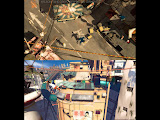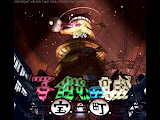circa 1998In many ways Tekkon was and still is one of the most creatively satisfying projects i've worked on. My good friend Michael Arias is one of those rare individuals who are equal parts left and right brained, and has the tenacity to not give up no matter the odds. He went on to complete the film eventually and is recognized as the first and only american to direct a japanese anime film.
When i did these sketches way back in the summer of 1998, it was after an inspiring reference trip to taiwan and hong kong, which provided the inspiration for Takaramachi at the time. (the fictional urban setting for Tekkon)
With the images of urban decay still fresh in our minds - images that were both beautiful and ugly at the same time - I made these concept sketches.
I had explained the designs to our director at the time Morimoto Koji in this way: "Imagine Disney World went out of business and an entire city full of asian squatters moved in and made it their home."
He laughed and we made the pilot.




















